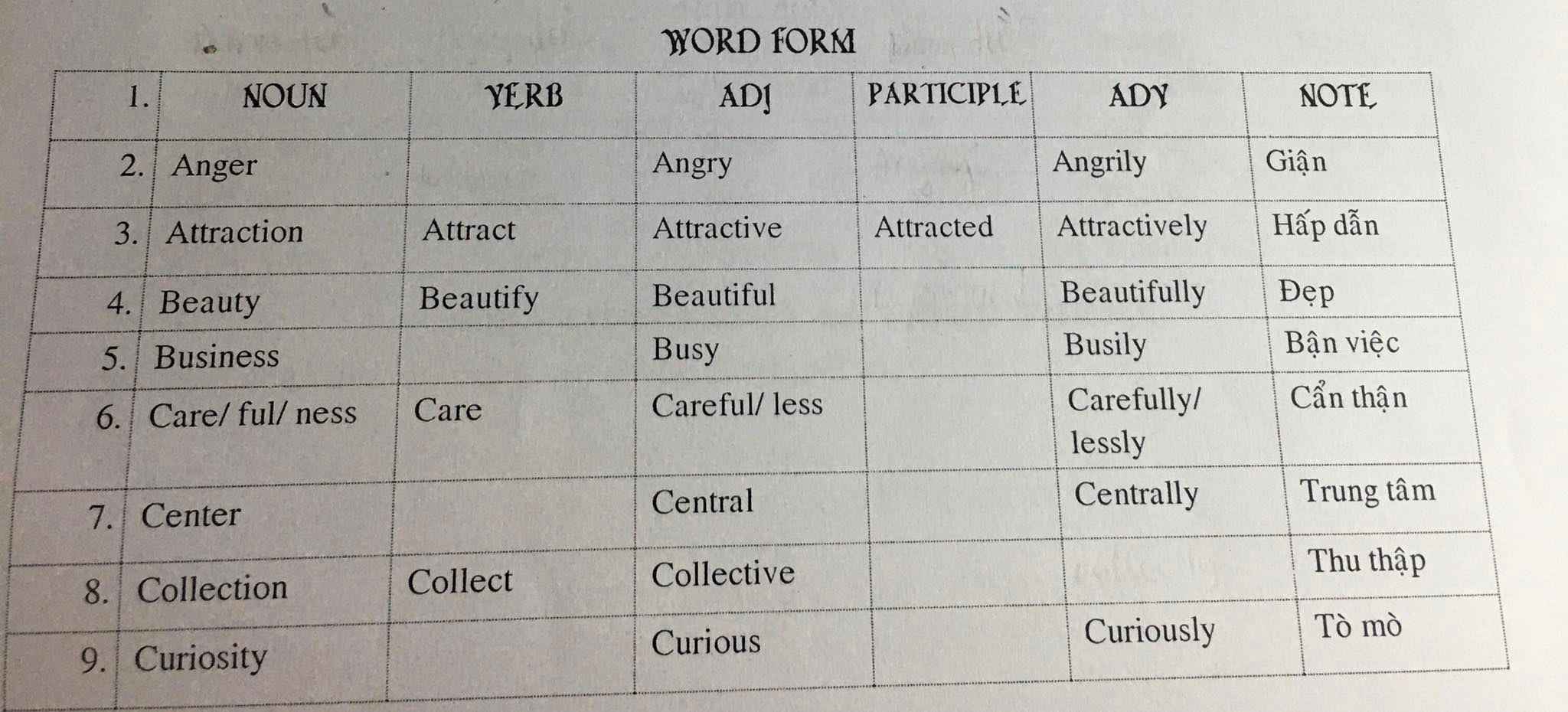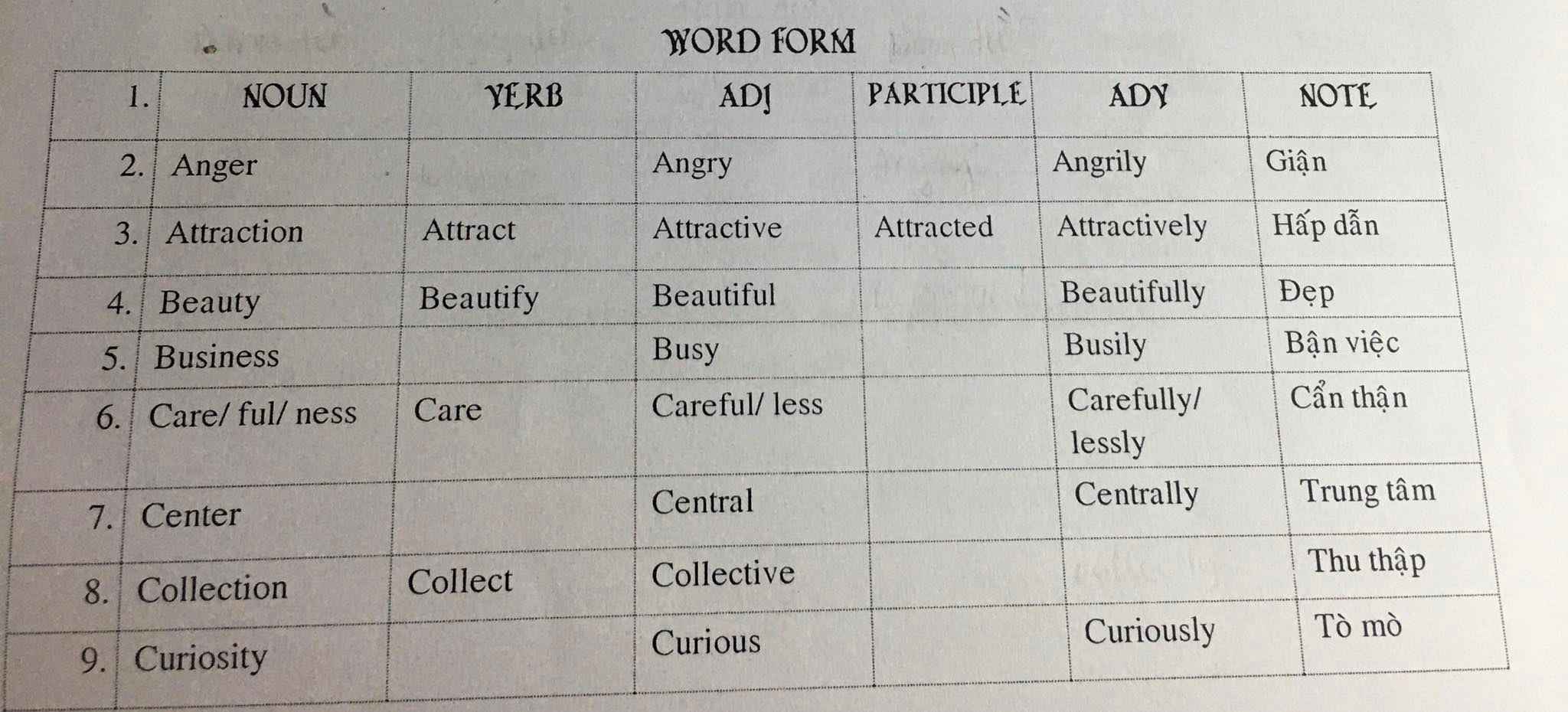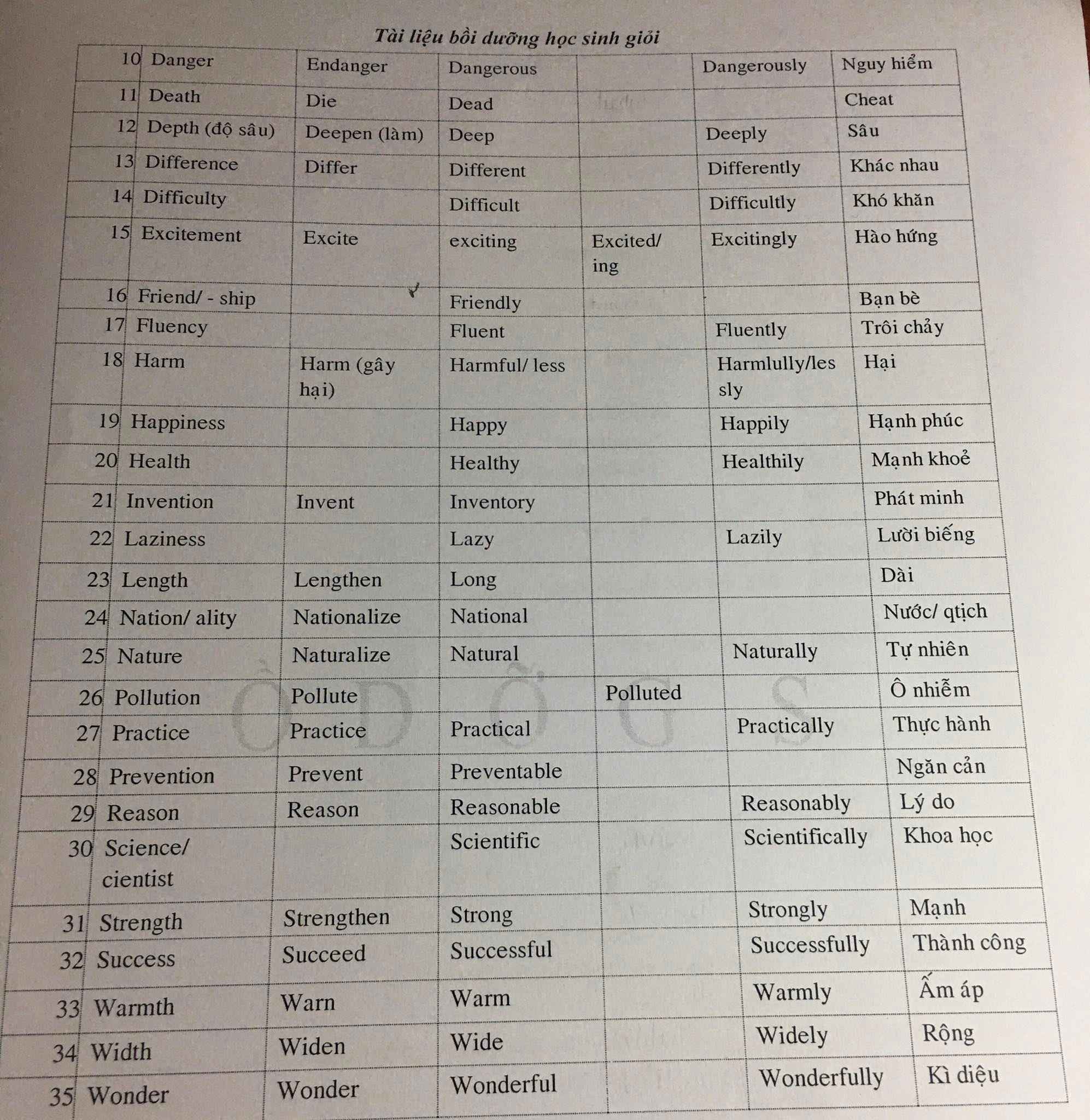
| DẠNG BÀI ĐIỀN TỪ VÀO ĐOẠN VĂN | ||||||
Dạng bài điền từ vào đoạn văn là dạng bài cung cấp những đoạn văn có chứa các chỗ trống và các lựa chọn cho sẵn để bạn lựa chọn đáp án đúng nhất điền vào đó. Những đáp án cần điền có thể liên quan đến ngữ pháp, từ vựng, liên từ, giới từ và cụm động từ. | ||||||
| NGUYÊN TẮC CHUNG KHI LÀM BÀI: | ||||||
1. Nhận biết các lựa chọn cho sẵn thuộc loại kiến thức nào (từ loại, các thì, mạo từ, ...) 2. Nhớ lại kiến thức liên quan đến các lựa chọn đó. 3. Xác định từ cần điền cho chỗ trống trong bài, dựa vào ngữ pháp, hàm ý và văn phong của đoạn văn để suy luận ra từ cần điền. 4. Tìm đáp án đúng cho chỗ trống. | ||||||
1. DẠNG 1: TỪ LOẠI | ||||||
| PHƯƠNG PHÁP LÀM BÀI: | ||||||
Từ loại trong tiếng Anh bao gồm: danh từ (noun), động từ (verb), tính từ (adjective), trạng từ (adverb). Để làm tốt dạng bài điền từ loại vào đoạn văn, bạn cần phải nắm chắc các quy tắc hình thành từ loại. Cùng một từ gốc, khi thêm tiền tố hoặc hậu tố hoặc biến đổi thành đuôi sẽ tạo thành một từ loại khác. | ||||||
| 2. DẠNG 2: CÁC THÌ | ||||||
| PHƯƠNG PHÁP LÀM BÀI: | ||||||
Trong tiếng Anh có 12 thì cơ bản, các em cần xem lại cấu trúc và cách sử dụng của từng Thì. Lưu ý: - Nếu trong câu cần điền từ không có trạng từ đi kèm, chúng ta có thể xác định thì của các câu đứng ở trước và sau, đồng thời kết hợp dịch nghĩa để tìm ra đáp án chính xác cần điền. | ||||||
| 3. DẠNG 3: GIỚI TỪ - CỤM ĐỘNG TỪ | ||||||
| PHƯƠNG PHÁP LÀM BÀI: | ||||||
Dạng bài điền giới từ vào đoạn văn rất phổ biến, để làm tốt được phần này, các em cần lưu ý những điều sau: - Ghi nhớ kiến thức về giới từ và cụm động từ. + Thuộc lòng cách sử dụng của những giới từ phổ biến (giới từ chỉ-thời gian, giới từ chỉ địa điểm ...) + Nắm vững cách sử dụng của các cụm giới từ (giới từ 4- động từ) và cụm động từ (động từ + giới từ) thường gặp. - Nâng cao kỹ năng làm bài: + Nhìn từ đứng trước và đứng sau chỗ trống cần điền để xem đó là loại giới từ gì hoặc cụm từ gì (chưa cần hiểu nghĩa). + Nếu là giới từ và cụm động từ cơ bản, chúng ta dễ dàng lựa chọn được đáp án. (VD: at + giờ; belong to, ...) + Nếu là giới từ và cụm động từ có nhiều nghĩa, chúng ta phải dịch nghĩa để có thể chọn được đáp án đúng (VD: get on (lên xe); get off (xuống xe)). | ||||||
| 4. DẠNG 4: CÂU ĐIỀU KIỆN | ||||||
| PHƯƠNG PHÁP LÀM BÀI: | ||||||
- Nắm vững cấu trúc và cách sử dụng của các loại câu điều kiện. - Xác định câu có chỗ trống cần điền thuộc câu điều kiện loại nào, dựa vào các vế cho sẵn. - Nếu chưa chắc chắn, em hãy đọc kỹ các câu đứng trước hoặc sau câu đó. - Lựa chọn đáp án đúng cần điền. | ||||||
Lưu ý: - Có những chỗ trống sẽ dùng dạng đảo ngữ của câu điều kiện, do vậy em cần ghi nhớ cả những kiến thức về phần này. | ||||||
| 5. DẠNG 5: CÂU BỊ ĐỘNG | ||||||
| PHƯƠNG PHÁP LÀM BÀI: | ||||||
Đối với dạng bài điền từ liên quan đến câu bị động thì chỗ trống cần điền thường là động từ của câu, do đó, cách làm dạng bài này là: - Xác định thì của câu có chỗ trống cần điền thông qua trạng từ đi kèm hoặc ý nghĩa. - Xác định chủ ngữ của câu cần điền (số ít hay số nhiều) - Lựa chọn đáp án đúng. | ||||||
| 6. DẠNG 6: DANH ĐỘNG TỪ - ĐỘNG TỪ NGUYÊN THỂ CÓ "TO"/KHÔNG "TO" | ||||||
| PHƯƠNG PHÁP LÀM BÀI: | ||||||
- Đọc lướt câu có chỗ trống cần điền để tìm cụm từ/ mẫu câu thường đi với danh động từ và động từ nguyên thể có “to” hoặc không “to”. - Chọn đáp án đúng với cụm từ/ mẫu câu đó. Lưu ý: - Cần phải ghi nhớ những cách sử dụng và vị trí của danh động từ và động từ nguyên thể có “to”/ không “to”. | ||||||
| 7. DẠNG 7: SO SÁNH | ||||||
| PHƯƠNG PHÁP LÀM BÀI: | ||||||
Xác định chỗ trống cần điền thuộc dạng so sánh nào, thông qua một vài dấu hiệu sau. + so sánh bằng: thường so sánh giữa 2 người/ vật/ sự việc, và đi kèm các từ “as/ not as”. + so sánh hơn/ kém: thường so sánh giữa 2 người/ vật/ sự việc, và đi kèm các từ “than/ more”. + so sánh nhất: thường so sánh một người/ vật/ sự việc với một nhóm tương ứng, và đi kèm các từ “the/ most/ of/ - Lựa chọn đáp án đúng với cấu trúc của dạng so sánh trong câu. - Lưu ý cách thành lập hình thức so sánh của tính từ/ trạng từ trong tiếng Anh để tránh chọn sai đáp án. | ||||||
| 8. DẠNG 8: MẠO TỪ | ||||||
| PHƯƠNG PHÁP LÀM BÀI: | ||||||
Để làm tốt được phần điền mạo từ, bạn cần phải ghi nhớ một vài cách sử dụng cơ bản của các mạo từ: a/ an/ the. | ||||||
|
Exercise 1: Read the following passage and mark the letter A, B, C or D to indicate the correct word or phrase that best fits each of the numbered blanks.
Nowadays more and more people are moving to live in the cities because of the facilities that they find there. Many people prefer living in cities (1)______ the opportunities of jobs, market places, big houses and buildings including schools and hospitals. But as the population in the city increases, the (2)______of cars, raw materials and others increase too. All this contributes to the pollution of the city and increases the size of the (3)______ faced by individuals. Our problems in the city contribute to the destruction of the city and the spread of corruption. Also, these problems are (4)______an atmosphere of discomfort and the inability of the individual to adapt and live in peace in his home town. However, there are many solutions (5)______can be used and applied to contribute to reducing the number of problems, such as increasing the number of police members, providing employment opportunities and spreading awareness among members of the society.
1. A. because of 2. A. selling 3. A. harms 4. A. making 5. A. that | B. because B. buying B. problems B. producing B. what | C. in spite of C. consumption C. troubles C. generating C. this | D. with D. conservation D. damages D. creating D. whether |
Exercise 2: Read the following passage and mark the letter A, B, C or D to indicate the correct word that best fits each of the numbered blanks.
Clinicians and health care staff work tirelessly to care for their patients in an increasingly complex, inefficient, and stressful environment. (1) _______, the structure, incentives, and culture of the system in which they work are often - perhaps usually - poorly aligned to support their efforts to respond to patients' needs as their core priority. Recognizing the imperative to centre on the patient, a learning health care system is one in (2) _______ patients and their families are key drivers of the design and operation of the learning process. When patients, their families, (3) _______ caregivers, and the public are full, active participants in care, health, the experience of care, and economic outcomes can be substantially improved.
Crossing the Quality Chasm underscores patient-centeredness as a core aim of the health care system, yet care often fails to (4) _______ this aim (IOM, 2001). Despite the Quality Chasm's call to action more than a decade ago, patient-centred care still is not the norm, and users continue to find the health care system uncoordinated and stressful to navigate. As the complexity of the system continues to grow with (5) _______ in science (Chapter 2), patient engagement takes on increased importance as a means of ensuring that patients can find the right care for their individual characteristics, needs, preferences, and circumstances.
(Adapted from https://www.ncbi.nlm.nih.gov/books)
1. A. Consequently B. Although C. Therefore D. However
2. A. that B. whose C. which D. what
3. A. others B. one C. another D. other
4. A. meet B. merge C. focus D. fracture
5. A. increases B. fame C. promotion D. advances
Exercise 1: Read the following passage and mark the letter A, B, C or D to indicate the correct word or phrase that best fits each of the numbered blanks.
Nowadays more and more people are moving to live in the cities because of the facilities that they find there. Many people prefer living in cities (1)______ the opportunities of jobs, market places, big houses and buildings including schools and hospitals. But as the population in the city increases, the (2)______of cars, raw materials and others increase too. All this contributes to the pollution of the city and increases the size of the (3)______ faced by individuals. Our problems in the city contribute to the destruction of the city and the spread of corruption. Also, these problems are (4)______an atmosphere of discomfort and the inability of the individual to adapt and live in peace in his home town. However, there are many solutions (5)______can be used and applied to contribute to reducing the number of problems, such as increasing the number of police members, providing employment opportunities and spreading awareness among members of the society.
1. A. because of 2. A. selling 3. A. harms 4. A. making 5. A. that | B. because B. buying B. problems B. producing B. what | C. in spite of C. consumption C. troubles C. generating C. this | D. with D. conservation D. damages D. creating D. whether |
Exercise 2: Read the following passage and mark the letter A, B, C or D to indicate the correct word that best fits each of the numbered blanks.
Clinicians and health care staff work tirelessly to care for their patients in an increasingly complex, inefficient, and stressful environment. (1) _______, the structure, incentives, and culture of the system in which they work are often - perhaps usually - poorly aligned to support their efforts to respond to patients' needs as their core priority. Recognizing the imperative to centre on the patient, a learning health care system is one in (2) _______ patients and their families are key drivers of the design and operation of the learning process. When patients, their families, (3) _______ caregivers, and the public are full, active participants in care, health, the experience of care, and economic outcomes can be substantially improved.
Crossing the Quality Chasm underscores patient-centeredness as a core aim of the health care system, yet care often fails to (4) _______ this aim (IOM, 2001). Despite the Quality Chasm's call to action more than a decade ago, patient-centred care still is not the norm, and users continue to find the health care system uncoordinated and stressful to navigate. As the complexity of the system continues to grow with (5) _______ in science (Chapter 2), patient engagement takes on increased importance as a means of ensuring that patients can find the right care for their individual characteristics, needs, preferences, and circumstances.
(Adapted from https://www.ncbi.nlm.nih.gov/books)
1. A. Consequently B. Although C. Therefore D. However
2. A. that B. whose C. which D. what
3. A. others B. one C. another D. other
4. A. meet B. merge C. focus D. fracture
5. A. increases B. fame C. promotion D. advances
(em ko biết có đúng ko nên mọi ng sửa dùm em nha)
sao tui thấy mỗi môn tiếng anh hoạt động sôi nổi thế nhở, đa số bài trên trang chính đều là tiếng anh















